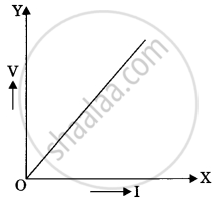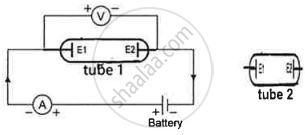Advertisements
Advertisements
प्रश्न
Consider a current carrying wire (current I) in the shape of a circle. Note that as the current progresses along the wire, the direction of j (current density) changes in an exact manner, while the current I remain unaffected. The agent that is essentially responsible for is ______.
विकल्प
source of emf.
electric field produced by charges accumulated on the surface of wire.
the charges just behind a given segment of wire which push them just the right way by repulsion.
the charges ahead.
उत्तर
Consider a current carrying wire (current I) in the shape of a circle. Note that as the current progresses along the wire, the direction of j (current density) changes in an exact manner, while the current I remain unaffected. The agent that is essentially responsible for is electric field produced by charges accumulated on the surface of wire.
Explanation:
Current per unit area (taken normal to the current), I/A, is called current density and is denoted by `vecJ`.

The SI unit of the current density ate A/m2. The current density is also directed along E and which is also a vector quantity and the relationship is given by
`vecJ = σvecE = vecE/ρ`
Where σ = conductivity and ρ = resistivity or specific resistance of the substance.
The `vecJ` changes due to the electric field produced by changes accumulated on the surface of wire.
APPEARS IN
संबंधित प्रश्न
Let the resistance of an electrical component remains constant while the potential difference across the two ends of the component decreases to half of its former value. What change will occur in the current through it?
Why are coils of electric toasters and electric irons made of an alloy rather than a pure metal?
A low voltage supply from which one needs high currents must have very low internal resistance. Why?
What is an Ohmic resistor?
A wire of resistance 3 ohm and length 10 cm is stretched to length 30 cm. Assuming that it has a uniform cross section, what will be its new resistance?
What length of copper wire of resistivity 1.7 × 10-8 Ω m and radius 1 mm is required so that its resistance is 2Ω?
The resistance of a nichrome wire at 0°C is 10Ω. If its temperature coefficient of resistivity of nichrome is 0.004/ °C, find its resistance of the wire at boiling point of water. Comment on the result.
The slope of voltage (V) versus current (I) is called:

What is the resistance of a conductor through which a current of 0.5 A flows when a potential difference of 2V is applied across its ends?
The circuit depicted in the figure is employed for studying Ohm's Law. Instead of using a standard resistor, a student opts for a glass tube filled with mercury (tube 1), connected to the circuit through two electrodes E1 & E2. He records the readings of the ammeter and voltmeter, thereby calculating the resistance. The student repeats the experiment by substituting tube 1 with tube 2, where the same amount of mercury fills the tube 2.

Neglecting internal resistance of the cell use (> or < or =) to compare
- the resistance in both the cases.
- the voltmeter readings in both the cases.
- the specific resistance in both the cases.
